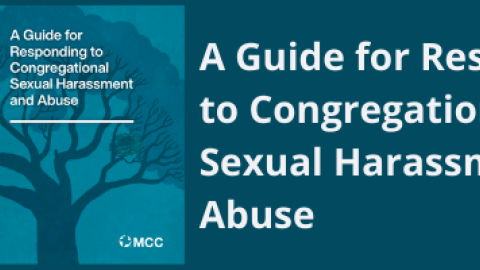A Guide for Responding to Congregational Sexual Harassment and Abuse: A Resource from the Mennonite Central Committee (MCC)

Mennonite Central Committee recently published "A Guide for Responding to Congregational Sexual Harassment and Abuse." There are many times that sexual harassment happens in a church or community that harms others and we as faith leaders, elders, deacons or pastors are unsure how best to go about these harms - whether they may appear minor or egregious.
This guide gives a concrete way for faith leaders to navigate these issues—particularly through a survivor lens so that more harm does not come from well intended church leaders seeking to acknowledge and make right where harm has occurred. Unfortunately, the processes we take to address harms often leads to further injury.
This well thought through guide, specifically with Mennonite churches in mind, is helpful for all faith communities for a principled process to both take seriously what has occurred and also create an opportunity for varying levels of responsibility to be taken on the part of those who have done harm, and for a pathway toward right relationships not only within the the relationship where harm occurred, but throughout the community as well.
As the guide puts it on page 6: "As a church we are committed to the work of nurturing healthy and respectful relationships that embody an ethic of love. This includes i) actively responding to those in our communities who have experienced harmful or violating actions in ways that prioritize healing and safety, and ii) recognizing that the call to forgiveness has often been misused in situations of power imbalance and harm, causing re-traumatization and enabling the harm-doer to perpetuate further injury. True restoration occurs only within a culture where truth-telling, safety, support and accountability are prioritized."
There are many times churches rely on Matthew 18:15 to encourage a confrontation person-to-person where someone did wrong. However, this principle should not be used where sexual harassment has occurred, instead this guide lays a protocol where the leadership body of a church takes more affirmative action. More can be read about this action on page 18, but a specific route this guide suggests (with several other prior action steps):
Two members of the leadership body will take the statement developed with the complainant and present it to the respondent. In this initial meeting the leadership members will:
- first present the event as the complainant experienced it
- ask the respondent to make an account of their experience of the event in question
- communicate any clear expectations made by the complainant
- ask that the respondent refrain from directly communicating to the complainant until further notice and outline consequences of breaching this request
- offer relevant resources to support the respondent in matters of care, insight, and behaviour. See Appendix 1. F. inform the respondent of the further steps (outlined in #5. of this section) that will be taken
- once accepted by the respondent a record of the report is to be kept on file
We encourage you to check out this guide as a resource for your church or faith community—and a big thank you to Mennonite Central Committee for their thoughtful work which is well researched and informed through first hand consultation and experience with congregations and those harmed by sexual harassment and misconduct.
Connect to The Network and add your own question, blog, resource, or job.
Add Your Post
Let's Discuss
We love your comments! Thank you for helping us uphold the Community Guidelines to make this an encouraging and respectful community for everyone.